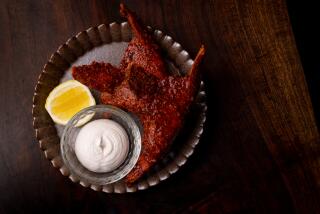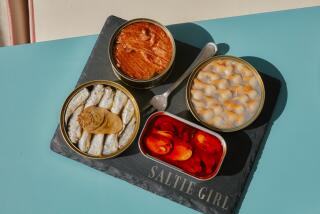Big Fish: Here’s Your ‘Cue
- Share via
There’s no getting around it: A big fish is an intimidating item. A 12-pound turkey just looks like Thanksgiving and a bunch of sandwiches, but a 12-pound bluefish looks like final exams at cooking school.
Looks, however, are deceptive. Cooking a large fish is easy--if you have a large barbecue grill--and there are many rewards.
The most important payoff is flavor. There’s far less danger of dryness when you cook a large fish whole, and the slight flavor of smoke is a definite plus. Bones are easier to remove, the price per pound of usable meat is generally lower and the inevitable leftovers are as versatile as the leftovers of Thanksgiving. Make bluefish sandwiches with sliced tomatoes, onions and mayonnaise; fresh tuna and potato salad; creamed salmon on toast; fish pie with a crust of herbed mashed potatoes on top.
Any large (6- to 14-pound) fish can be cooked in a covered kettle grill, but fattier types such as salmon and tuna, being self-basting, respond particularly well. Measure your grill before shopping. Have the fishmonger remove the fish head, which can be cooked alongside the fish or frozen for future soup, then measure the fish and have a section of tail cut off, if necessary.
Prepare a deep bed of hardwood coals. They should be well burned down so the heat they give off is moderate, but there must be enough of them to maintain cooking temperature for 40 minutes or so. When they are ready, rake about two-thirds of them to one side so there will be more heat under the thick end of the fish. Let the grill heat thoroughly.
Rinse the fish well, being sure no blood is left along the backbone, pat it dry with paper towels, then rub it all over with tamari or some other aged soy sauce. Place it on the hot grill, cover with the lid and cook for about 10 minutes per inch of thickness, measured at the fish’s thickest part. Test for doneness by inserting a thin knife blade along the backbone at the thickest part and prying up--the flesh should be just barely opaque. To be on the safe side, test for the first time when the fish is supposedly only half done.
When the fish is ready, cover the work surface with a bed of newspaper. Pick up the grill and turn the fish out onto the paper. Replace the grill so the heat can clean it. Skin the fish or not, as desired, and remove the upper fillet, in sections, to a serving platter. Lift out the rack of bones and remove the remaining meat. Bundle all the debris in the newspaper and burn it on the leftover coals.
A simple sauce of melted butter with lemon juice and capers will set off the fish just fine. It’s also tasty with hot salsa, a mustard cream, the cucumber-dill sauce that follows or anything else that carries a bit of sharpness.
This is one of those universal sauces, as good on hot baked potatoes as it is on cold fish or chicken. With any luck, the cucumber you buy will be nice, summery, wax-free and unsprayed. If it isn’t, peel it before using.
CUCUMBER AND DILL SAUCE FOR COLD FISH
1 small cucumber, coarsely shredded to 1 heaping cup
1/2 teaspoon salt
1 large clove garlic
1 1/2 cups plain yogurt
1 tablespoon sugar
1/2 to 1 cup tender dill tips (lightly piled), depending on strength
Combine cucumber with salt and let stand about 10 minutes.
Drain cucumber, pressing to remove all possible liquid. Combine with garlic, yogurt and sugar in bowl. Mince 1/2 dill and add to cucumber mixture. Let stand 2 minutes. Taste and add additional dill until balance is pleasing. Makes about 2 1/2 cups, or 6 to 8 servings.
Salad Variation:
Double amount of cucumber and slice instead of shredding. Use double amount yogurt. Add some very thinly sliced onion. A couple of cooked beets never hurt anybody.
More to Read
Eat your way across L.A.
Get our weekly Tasting Notes newsletter for reviews, news and more.
You may occasionally receive promotional content from the Los Angeles Times.








